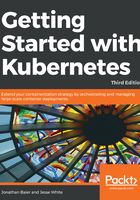
上QQ阅读APP看书,第一时间看更新
IAM setup
In order for us to use kops, we'll need an IAM role created in AWS with the following permissions:
AmazonEC2FullAccess
AmazonRoute53FullAccess
AmazonS3FullAccess
IAMFullAccess
AmazonVPCFullAccess
Once you've created those pieces manually in the AWS GUI, you can run the following commands from your PC to set up permissions with the correct access:
aws iam create-group --group-name kops
aws iam attach-group-policy --policy-arn arn:aws:iam::aws:policy/AmazonEC2FullAccess --group-name kops
aws iam attach-group-policy --policy-arn arn:aws:iam::aws:policy/AmazonRoute53FullAccess --group-name kops
aws iam attach-group-policy --policy-arn arn:aws:iam::aws:policy/AmazonS3FullAccess --group-name kops
aws iam attach-group-policy --policy-arn arn:aws:iam::aws:policy/IAMFullAccess --group-name kops
aws iam attach-group-policy --policy-arn arn:aws:iam::aws:policy/AmazonVPCFullAccess --group-name kops
aws iam create-user --user-name kops
aws iam add-user-to-group --user-name kops --group-name kops
aws iam create-access-key --user-name kops
In order to use this newly created kops user to interact with the kops tool, you need to copy down the SecretAccessKey and AccessKeyID from the output JSON, and then configure the AWS CLI as follows:
# configure the aws client to use your new IAM user
aws configure # Use your new access and secret key here
aws iam list-users # you should see a list of all your IAM users here
# Because "aws configure" doesn't export these vars for kops to use, we export them now
export AWS_ACCESS_KEY_ID=$(aws configure get aws_access_key_id)
export AWS_SECRET_ACCESS_KEY=$(aws configure get aws_secret_access_key)
We're going to use a gossip-based cluster to bypass a kops configuration requirement of public DNS zones. This requires kops 1.6.2 or later, and allows you to create a locally registered cluster that requires a name ending in .k8s.local. More on that in a bit.
If you'd like to explore how to purchase and set up publicly routable DNS through a provider, you can review the available scenarios in the kops documentation here: https://github.com/kubernetes/kops/blob/master/docs/aws.md#configure-dns.